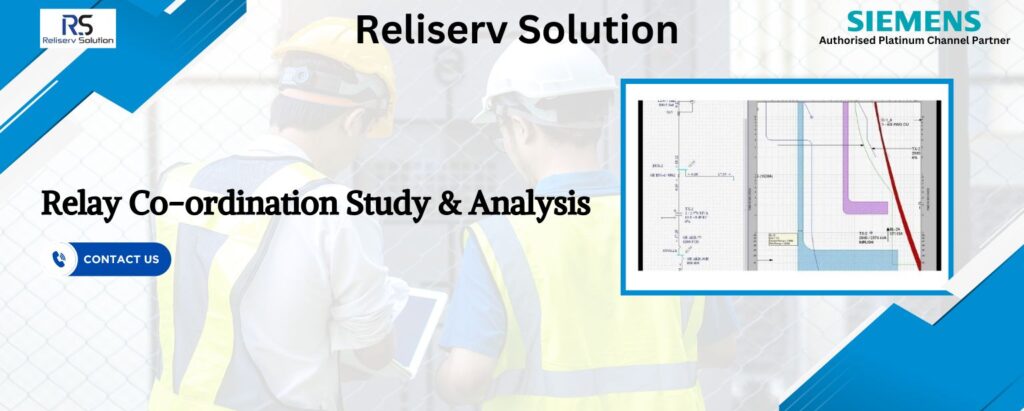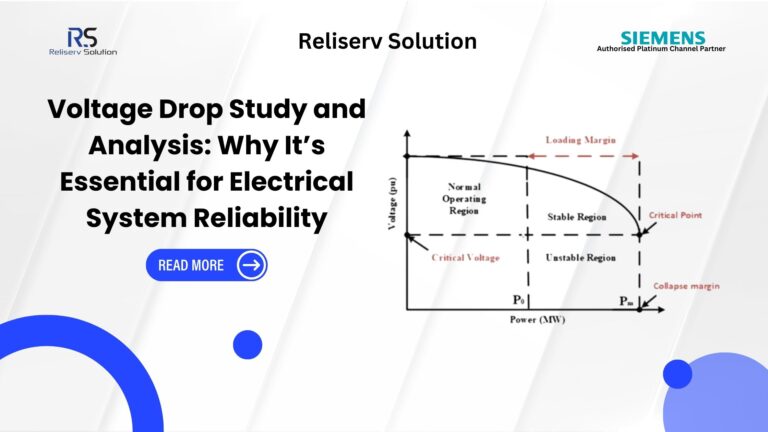Grid stability is paramount in maintaining the reliability and efficiency of electrical power systems. In complex networks with numerous protective relays, ensuring proper coordination among these relays is essential to prevent unnecessary tripping, minimize equipment damage, and maintain uninterrupted power supply. Relay coordination study and analysis play a crucial role in achieving this objective which belong to Power system studies in Mumbai. In this blog, we’ll delve into the significance of relay coordination study & analysis in ensuring grid stability, explore the key concepts involved, and discuss the methodologies and tools used in this process.
An Overview of the Relay Coordination Study & Analysis
Relay coordination study & analysis refers to the systematic process of setting protective relay operating parameters to ensure that they operate in a coordinated manner during fault conditions for Power system studies in Mumbai. The goal of relay coordination is to selectively isolate the faulty section of the power system while maintaining continuity of service for the rest of the network. This involves determining the time-current characteristics of protective relays, adjusting their settings, and coordinating their operation to achieve the desired protection scheme.
Relay Coordination Study & Analysis service: Circuit breakers and power system protection relays are the main tools for big, networked power systems in power system research. To separate the problematic area from the more robust network, we require appropriate security. Two protective devices placed in series are referred to as coordinated or selected when they share specific features that offer a predetermined functioning sequence. In order to separate the power system’s faulty portions, coordination schemes must provide quick, accurate, and dependable relay operation. This makes relay coordination a crucial component of protection system design.
WHY RELAY COORDINATION STUDY AND ANALYSIS ARE DONE?
Since protection is a top priority in any industry, where protective devices are essential, relay coordination study and analysis are carried out to ensure that the system is operating safely and to prevent annoying tripping. The alteration of protection devices and their settings during maintenance without doing appropriate research and analysis is the cause of nuisance tripping.
- When designing a new system, approximately choose protection and usage equipment.
- When new loads are added to an existing system or it is updated.
- When more highly rated equipment is used to replace the old equipment.
Importance of Relay Coordination Study & Analysis
- Fault Clearing Time: Proper relay coordination ensures that protective devices operate within the specified time limits to clear faults promptly. By coordinating the settings of relays along the protection zone for Power system studies in Mumbai, the fault-clearing time can be optimized to minimize disruption to the system and reduce the risk of equipment damage.
- Selectivity: Selective coordination ensures that only the relay closest to the fault operates to isolate the faulted section while allowing upstream relays to remain unaffected. This prevents unnecessary tripping of healthy portions of the system and maintains continuity of service for critical loads.
- System Stability: Relay coordination enhances the overall stability of the power system by preventing cascading failures and voltage instability during fault conditions for Power system studies in Mumbai. Properly coordinated relays help isolate faults quickly and prevent the propagation of disturbances throughout the network.
- Equipment Protection: Effective relay coordination protects electrical equipment from damage by ensuring that protective devices operate within their thermal and mechanical limits to Relay coordination Analysis Service. By coordinating relay settings based on the characteristics of equipment and system impedance, overcurrent and overvoltage conditions can be detected and mitigated promptly.
WHAT IS DONE DURING A RELAY COORDINATION STUDY & ANALYSIS SERVICE?
The standard employed for this investigation is ANSI / IEEE Std. 242 – 1986 (Recommended Practice for Protection and Coordination of Industrial and Commercial Power System).
Computer assistance is used mostly in Relay Coordination Study & Analysis services. A number of computer programs are available for power system application protection coordination analysis. Device time current characteristics and short circuit analysis are examples of such programs. The protective coordination program is primarily used to generate time-current coordination drawings, relay-setting calculations, and one-line diagrams.
- Personal computer: With enough RAM, either standalone or networked, is required for this kind of application. It also needs a high-quality laser printer and graphical display. Using a personal computer to conduct the study allows for the examination of multiple options prior to determining the best course of action. The information can be kept on file in the computer for later usage or computation validation. Printing the TCC, the output, and the one-line drawings is possible for a report. As an alternative, you can copy and paste these files into word processing programs.
- Graphical display: The device coordination curves and the electrical circuit’s one-line diagram can be seen in action on the graphical monitor of the Relay coordination Analysis Service. This kind of display aids in determining the adjustments that must be made before the diagrams or graphs may be printed for Power system studies in Mumbai.
- One-line diagram: When preparing a report, a one-line diagram of the electrical circuit for which coordination is done is always required. The required devices can be displayed in a one-line diagram created by the software. By using this method, dealing with the drawing office support for the protection research is avoided.

Methodologies and Tools for Relay Coordination Study & Analysis
- Time-Current Coordination (TCC) Curves: TCC curves depict the relationship between relay operating time and fault current magnitude. Analyzing TCC curves helps engineers determine the coordination settings for protective relays and identify potential coordination issues such as overlap or gaps in protection zones.
- Computer-Aided Relay Coordination Software: Advanced software tools, such as ETAP, DigSILENT, and SKM PowerTools, facilitate relay coordination studies by automating the analysis of TCC curves, performing time-domain simulations, and optimizing relay settings for coordination and selectivity to Relay coordination Analysis Service.
- Field Testing and Commissioning: Field testing and commissioning are essential components of relay coordination studies to verify the performance of protective relays in real-world conditions. Field engineers conduct testing to validate relay settings, verify coordination, and fine-tune parameters as needed to achieve optimal performance.
WHAT IS THE TECHNIQUE OF RELAY COORDINATION STUDY & ANALYSIS?
Obtain or draw a one-line diagram of the system or the relevant portion of the system if the study is on a new or existing system for Relay Coordination Analysis Service. These data should be displayed in the diagram:
- All transformers’ connections Relay coordination Analysis Service, apparent power and voltage ratings, and impedance ratings.
- Both regular and emergency switching scenarios.
- All main motors and generators’ nameplate ratings, sub-transient reactance, transient reactance of synchronous motors and generators, and synchronous reactance of generators are provided.
- Conductor types, sizes, and arrangements.
- Transformer ratios for current.
- The ratings, properties, and adjustment ranges of relays, circuit breakers, and fuses.
Conclusion
Relay coordination study and analysis are critical aspects of power system protection, ensuring the reliable and stable operation of electrical grids. By coordinating the settings of protective relays, engineers can minimize the impact of faults, enhance system reliability, and safeguard equipment from damage.
Through the use of advanced methodologies and tools, such as TCC curves and computer-aided software, relay coordination studies can be conducted efficiently and accurately, leading to optimized protection schemes and improved grid stability.
As the demand for reliable electricity supply continues to grow, the importance of relay coordination in ensuring grid stability cannot be overstated, making it an indispensable aspect of power system engineering and operation.
Utilize Relay Coordination Study & Analysis to Guarantee Grid Stability! Examine how important it is to optimize protection settings for dependable performance. Reliserv Solution is well-known for being among the leading solution providers of Relay Coordination Study & Analysis. Mumbai, Maharashtra, is home to the company’s headquarters. In addition, we provide a wide range of services and tailored solutions for different panel builders and industries. If you need help or have any questions, please email us at [email protected] or give us a call at +917506112097. You are welcome to browse our carefully chosen inventory of Power System Studies by clicking here, which includes the well-known Relay Coordination Study & Analysis.



